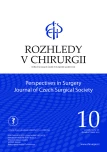The role of intraoperative frozen section of central neck lymph nodes in the management of patients preoperatively diagnosed with low- risk differentiated cancer
Authors:
R. Králik 1; M. Grigerová 2; E. Takácsová 3; M. Arciniegas 1; M. Sabol 1; V. Rekeň 1; Š. Nemergut 1; L. Gocký 1; D. Šintál 1; J. Podoba 2; Š. Durdík 1
Authors‘ workplace:
Klinika onkologickej chirurgie, Lekárska fakulta Univerzity Komenského a Onkologický ústav sv. Alžbety, Bratislava
1; Endokrinologická klinika, Slovenská zdravotnícka univerzita a Onkologický ústav sv. Alžbety, Bratislava
2; Klinika nukleárnej medicíny, Lekárska fakulta Univerzita Komenského, Slovenská zdravotnícka univerzita a Onkologický ústav sv. Alžbety, Bratislava
3
Published in:
Rozhl. Chir., 2022, roč. 101, č. 10, s. 494-498.
Category:
Original articles
doi:
https://doi.org/10.33699/PIS.2022.101.10.494–498
Overview
Introduction: Histological examination during surgery (FS) has a place in the surgical management of differentiated thyroid carcinoma (DTC). Extending the indication for limited surgery to 4 cm tumor size (ATA guidelines 2015) cytologically verified DTCs, increases the emphasis on accurate patient selection. In our work, we reflected on the effectiveness of FS and its relationship to optimal patient management.
Methods: In a single-center retrospective study, we evaluated the documentation of patients indicated for primary surgery for DTC from January 1, 2016 to December 31, 2020 – there was 489 patients collectively, 121 were men, median age was 50 years (16−81), 73 patients (female, age 18−45 years) with preoperatively identified low-risk DTC (size 11−40mm) were indicated for lobectomy.
Results: 34 patients (46.6%) did not meet the criteria for limited surgery − 15 patients were identified from FS of the lymph nodes of the central compartment (LNCK) (15 of 25 patients) – 1 patient with false negative result and 6 patients with FS of the thyroid gland (SH) (6 / 41) – 11 patients with false negative findings. Two-step OP surgery was performed on 13 patients (17.8%). FS of LNCK identified high-risk cancer and reduced the risk of two-step surgery compared to the group of patients in whom FS was not performed or was performed from thyroid gland. The difference was statistically significant (OR 1.93, p=0.026).
Conclusion: Approximately ½ of the patients from preoperatively identified low-risk cancers in our cohort met the criteria for limited surgery. About 30% of them eventually needed a two-step operation. Perioperative examination of LNCK helps to perform radical surgery at one time.
Keywords:
surgery – thyroid gland – frozen section – low-risk differentiated cancer
Sources
1. Chan S, Karamali K, Kolodziejczyk A, et al. Systematic review of recurrence rate after hemithyroidectomy for lowrisk well-differentiated thyroid cancer. Eur Thyroid J. 2020;9(2):73−84. doi: 10.1159/000504961.
2. Haugen BR, Alexander EK, Bible KC, et al. American Thyroid Association management guidelines for adult patients with thyroid nodules and differentiated thyroid cancer: the American Thyroid Association guidelines task force on thyroid nodules and differentiated thyroid cancer. Thyroid 2016;26(1):1–133. doi: 10.1089/thy.2015.0020.
3. Orloff LA, Wiseman SM, Bernet VJ, et al. American Thyroid Association statement on postoperative hypoparathyroidism: Diagnosis, prevention, and management in adults. Thyroid 2018;28(7):830−841. doi: 10.1089/thy. 2017.0309
4. Park S, Jeon MJ, Song E, et al. Clinical features of early and late postoperative hypothyroidism after lobectomy. J Clin Endocrinol Metab. 2017;102(4):1317−1324. doi: 10.1210/jc.2016-3597.
5. Kaušitz J, Ondruš D a kol. Špeciálna onkológia. 1. vyd. Bratislava, Solen 2020, 712 s. ISBN 978-80-89858-18-7.
6. McHenry CR, Raeburn C, Strickland T, et al. The utility of routine frozen section examination for intraoperative diagnosis of thyroid cancer. Am J Surg. 1996 Dec;172(6):658−661. doi: 10.1016/s0002- 9610(96)00302-9.
7. Park YM, Wang SG, Goh JY, et al. Intraoperative frozen section for the evaluation of extrathyroidal extension in papillary thyroid cancer. World J Surg. 2015;39(1):187−193. doi: 10.1007/ s00268-014-2795-5.
8. LiVolsi VA, Baloch ZW. Use and abuse of frozen section in the diagnosis of follicular thyroid lesions. Endocr Pathol. 2005 Winter;16(4):285−293. doi: 10.1385/ ep:16:4:285.
9. Chang HY, Lin JD, Chen JF, et al. Correlation of fine needle aspiration cytology and frozen section biopsies in the diagnosis of thyroid nodules. J Clin Pathol. 1997;50(12):1005−1009. doi:10.1136/ jcp.50.12.1005.
10. Mallick R, Stevens TM, Winokur TS, et al. Is frozen-section analysis during thyroid operation useful in the era of molecular testing? J Am Coll Surg. 2019;228(4):474−479. doi: 10.1016/j.jamcollsurg.2018.12.002.
11. Kahmke R, Lee WT, Puscas L, et al. Utility of intraoperative frozen sections during thyroid surgery. Int J Otolaryngol. 2013;2013:496138. doi:10.1155/ 2013/496138.
12. Richards ML, Chisholm R, Bruder JM, et al. Is thyroid frozen section too much for too little? American Journal of Surgery 2002;184:510–514, discussion 514. doi: 10.1016/s0002-9610(02)01074-7.
13. Albano D, Bertagna F, Bonacina M, et al. Possible delayed diagnosis and treatment of metastatic differentiated thyroid cancer by adopting the 2015 ATA guidelines. Eur J Endocrinol. 2018;179(3):143−151. doi: 10.1530/EJE-18-0253.
14. Yeh MW, Bauer AJ, Bernet VA, et al. American Thyroid Association Surgical Affairs Committee writing task force. American Thyroid Association statement on preoperative imaging for thyroid cancer surgery. Thyroid. 2015;25(1):3−14. doi: 10.1089/thy.2014.0096.
15. Agrawal N, Evasovich MR, Kandil E, et al. Indications and extent of central neck dissection for papillary thyroid cancer: An American Head and Neck Society consensus statement. Head Neck 2017;39(7):1269−1279. doi: 10.1002/ hed.24715.
16. Randolph GW, Duh QY, Heller KS, et al. American Thyroid Association Surgical Affairs Committee’s task force on thyroid cancer nodal surgery. The prognostic significance of nodal metastases from papillary thyroid carcinoma can be stratified based on the size and number of metastatic lymph nodes, as well as the presence of extranodal extension. Thyroid 2012;22(11):1144−1152. doi: 10.1089/ thy.2012.0043.
17. Raffaelli M, Sessa L, De Crea C, et al. Is it possible to intraoperatively modulate the extent of thyroidectomy in small papillary thyroid carcinoma? Surgery 2021;169(1):77−81. doi: 10.1016/j. surg.2020.04.043.
18. Al-Qurayshi Z, Christopher B. Sullivan CHB, et al. Prevalence and risk of metastatic thyroid cancers and management outcomes: A national perspective. NA Laryngoscope 2021;131:237–244. doi: 10.1002/lary.28722.
Labels
Surgery Orthopaedics Trauma surgeryArticle was published in
Perspectives in Surgery

2022 Issue 10
Most read in this issue
- Cholangiocelulární karcinom z pohledu patologa
- Acute appendicitis in supraumbilical hernia
- Prognostic factors of renal cell carcinoma
- Inflammatory cloacogenic polyp in an adolescent – case report and review of the literature
